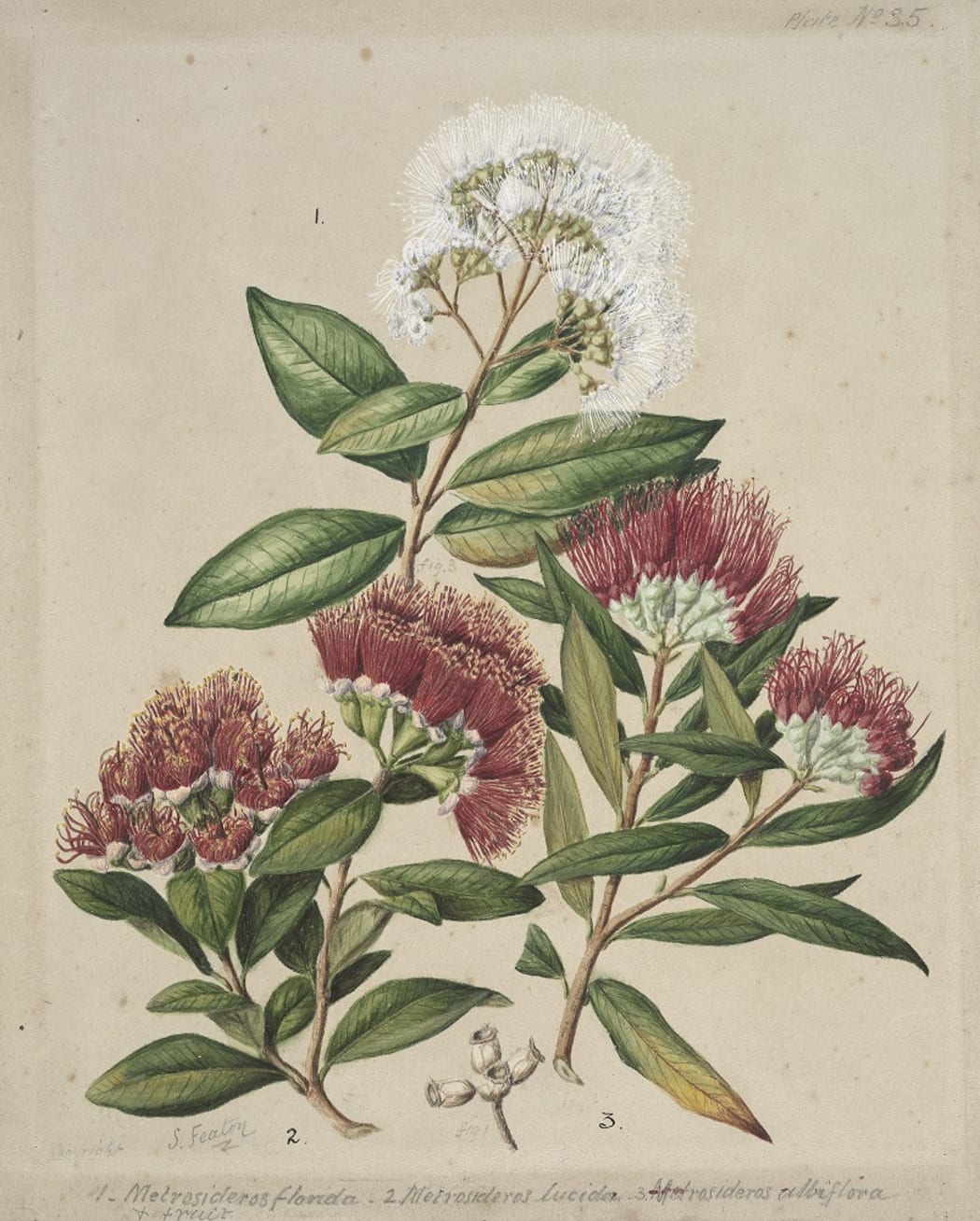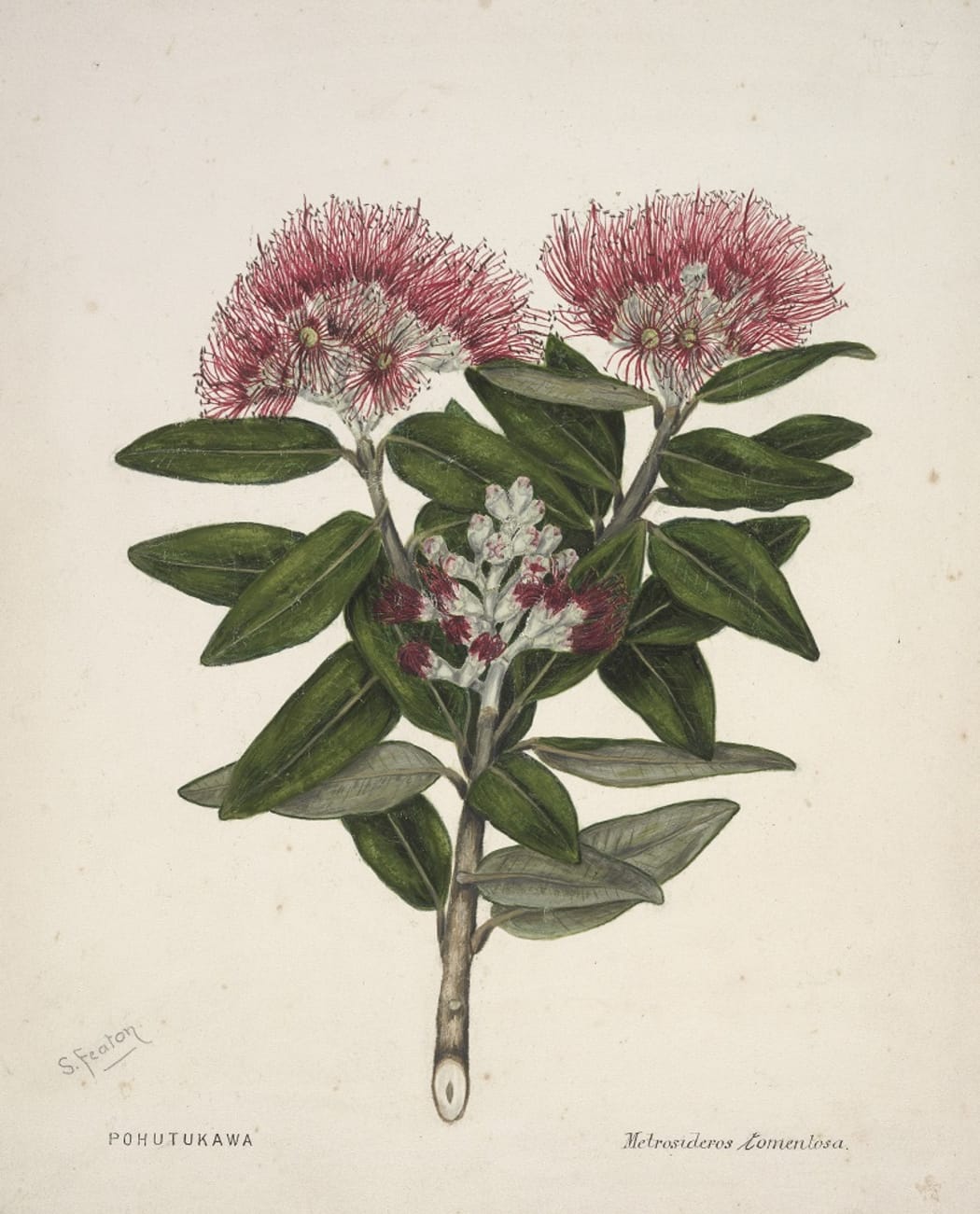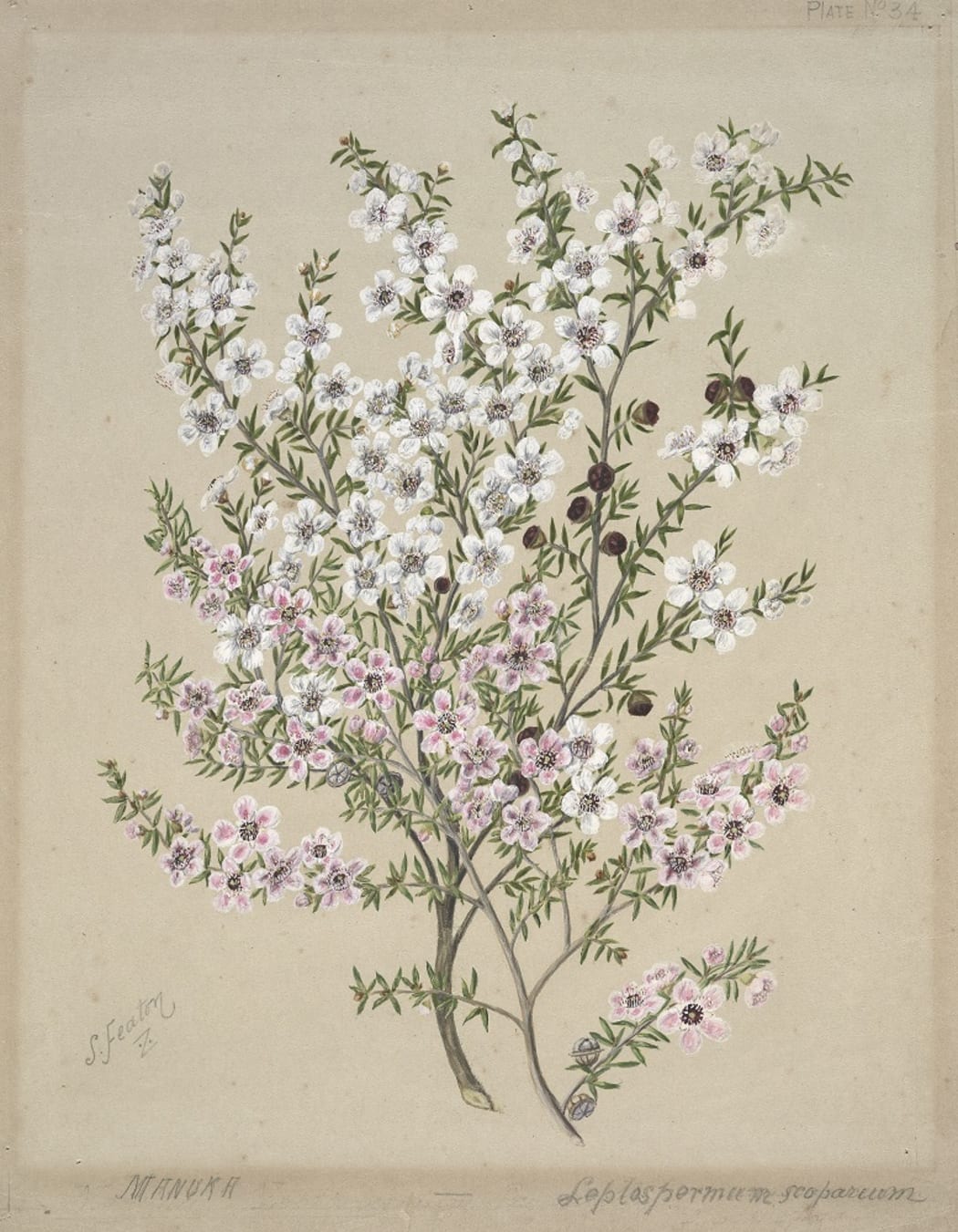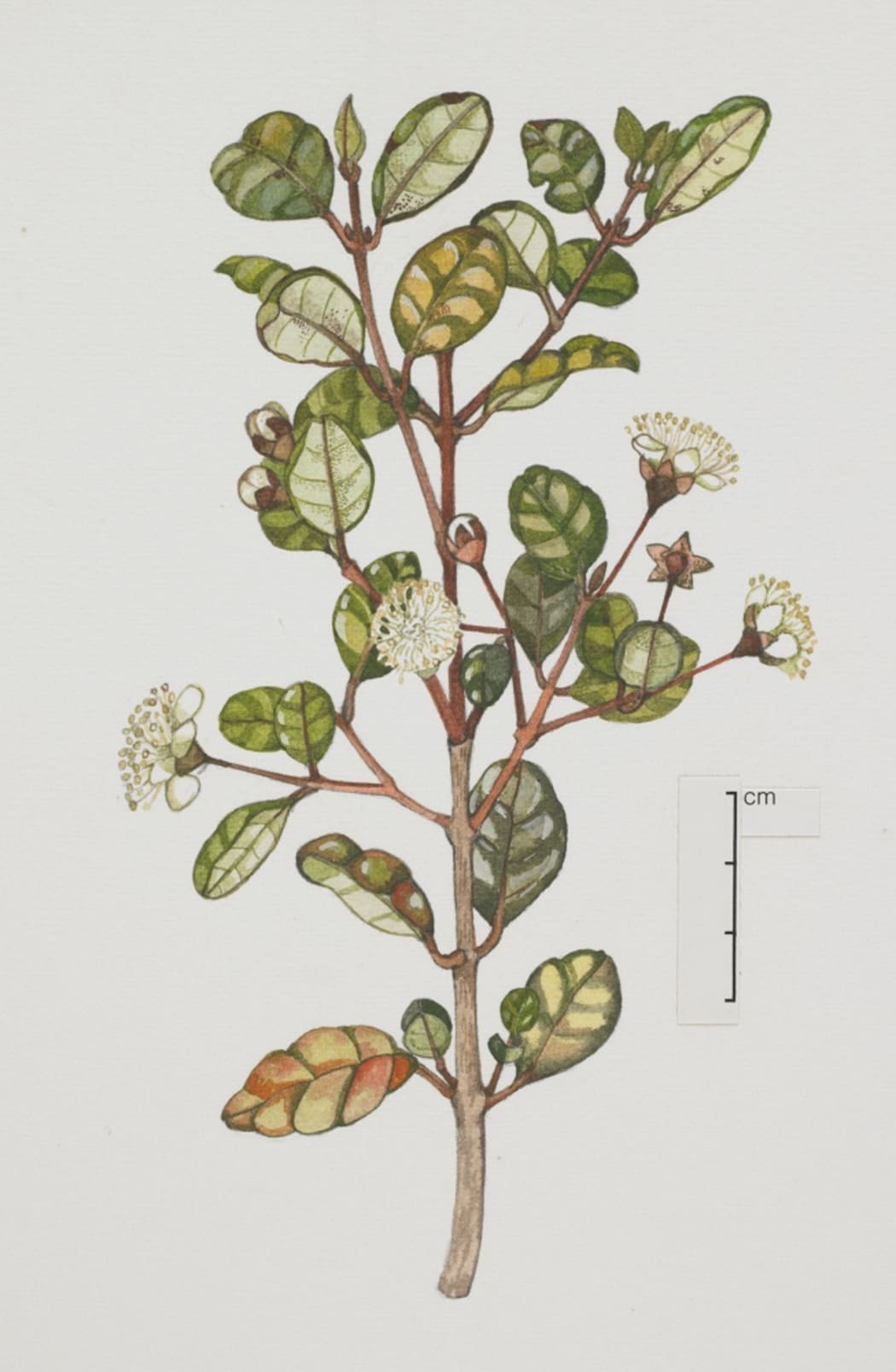Our rātā, pōhutukawa, mānuka and kānuka are taonga. How can we protect them from myrtle rust?

1. White rata. 2.Climbing rata. 3.Southern rata. Photo: Illustration: Sarah Featon, Circa 1885 / Te Papa
Three small pockets of dense, ancient forest in the Far North of New Zealand are home to one of the world’s rarest species of tree: the rātā moehau.
Also known as Bartlett’s rātā, only 12 of these majestic, white-flowered giants remain in the wild.
To local iwi, Ngati Kuri, rātā moehau is a taonga.
But the incursion of myrtle rust into New Zealand could see its extinction.
***
Rongoā Māori (Māori healing) practitioner Donna Kerridge says a risk to myrtle species like mānuka and kānuka is a risk to the delicate balance of New Zealand’s native ecosystem.
“Mānuka and kānuka pave the way. They prepare the ground for other plants to populate the earth where it’s been damaged.
“They are the first to come up after the ground’s been burnt. They heal the land so that other plants can start to regenerate in their shade. They hold the moisture in the ground that will allow other plants to start populating what could have been barren areas.”
If these species are destroyed by myrtle rust, Kerridge wonders how the land will heal.
***
Myrtle rust is a fungal disease that was likely blown to New Zealand from Australia.
It was first found in Kerikeri in May. Since then, it has been found on 46 properties in Taranaki, Northland, Bay of Plenty and Waikato.
The disease attacks the foliage of plants in the myrtle family - including New Zealand’s about 48 native species. Spores germinate on the surface of leaves, then punch their way through to attack the plant’s cells, which they feed off. Leaves become buckled and twisted, and die.
Myrtle rust prefers warm, humid conditions - much like those that can be found in New Zealand’s subtropical north.
***
Many of Aotearoa’s native species at risk from infection with myrtle rust are taonga, and the Māori relationship with them is one of kaitiakitanga (guardianship).
Myrtle species have been used in medicine, construction and food, and individual plants can have significant cultural value.
“Pōhutukawa and rātā can be wahi tapu, urupa,” says Auckland Council’s Dr Nick Waipara.
“Often bones were kept in pōhutukawa hollows. Trees were used as markers for navigation or boundaries. The cultural impact is a much wider scenario than just the environment.
“Te ao Māori sees our taonga species as tuakana, as siblings, so it goes beyond the risk to pōhutukawa as a species, it’s also the risk to the wider cultural values to te ao Māori,” Waipara says.
At Cape Reinga, spirits of the dead slide down the roots of an ancient pōhutukawa on their way to Hawaiki.
At Kawhia, Tangi-te-korowhiti - the tree to which the Tainui waka is said to have been tied upon arrival in New Zealand - clings to the edge of a bank, its branches drooping into the tidal waters of the harbour.
At Te Araroa, the birthplace of Sir Āpirana Ngata, Te Waha o Rerekohu is said to be the largest pōhutukawa in New Zealand.
In 1907, ethnographer Elsdon Best wrote of the northern rātā: “This huge tree was held in much esteem in former times... Most of these trees had special names, such as Te Tohu a te Ropu, a rātā tree at O-haua, which is said to be always the first to bloom of such trees in that vicinity.
“In the old-time legend of Tawhaki and his ascent to the heavens, it is stated that after his encounter with Tama-i-waho the hapless Tawhaki fell from the heavens and perished at the place where the sky hangs down.
“When the people of this lower world awoke next morn, behold! The rātā, the pāhutukawa, the kōwhai trees were all red, reddened by the blood of Tawhaki.”
Mānuka can be used to lift a makutu (spell), and is known as the best wood for a hāngi.

Pohutukawa - Metrosideros tomentosa. Photo: Illustration: Sarah Featon, circa 1888 / Te Papa
In his role at the council, Dr Nick Waipara promotes research prioritised by Māori. He also leads the Māori Solutions to Biosecurity Threats project, which last year began to look at the potential impact of myrtle rust on taonga species.
Part of that project involved working with Māori communities that could be affected by the disease, to decide on biosecurity risks, priorities and the impact myrtle rust could have on economy, culture and kaitiakitanga.
In addition to other pressures on our native myrtles - from possums, habitat destruction, weeds, urbanisation and climate change - Waipara says he worries myrtle rust could be a tipping point.
***
The Aupōuri Peninsula, in the Far North, was originally a series of islands that are now connected by land. Much of the pristine forest in the area was burned for agriculture, but several patches of dense native bush survived, as have some special plants that are not found elsewhere.
In the Ngati Kuri rohe, which extends from just south of Houhora, north to the Three Kings and Kermadec Islands, three of these patches near Spirits Bay are home to the rātā moehau.
Usually beginning their lives as epiphytes, like the more common northern rātā, the roots of the rātā moehau slowly make their way to the earth below, eventually forming a pale, papery trunk around the host tree.
In 1992, 34 wild trees were documented, but in 2007 seven were found to have been killed by possums, while others were severely damaged.
In 2015, Department of Conservation staff discovered that only one tree in a stand of 16 remained, though they found three more nearby. DOC took samples of the remaining trees, and found only five individual genotypes in the wild - meaning genetic variation among the trees is extremely limited. Scientists also found that in cultivation, all rātā moehau were descended from one individual - meaning they are essentially clones.
Today, only 12 trees remain in the wild, and a project is underway to raise more genetically viable plants in cultivation.
For Ngati Kuri, this means their role as kaitiaki is critical.
“We just keep pressing on and do the best we can,” says iwi trust chairman Harry Burkhardt.
“We’ve got local people keeping an eye out, and we’re thinking about seed banking. There are a few cuttings sitting at the Auckland botanic gardens, and the week before last we took some cuttings off those and sent them down to Dunedin botanic gardens.”
Burkhardt says it’s still early days, and the rust hasn’t been detected in the rohe yet.
“There’s a quiet inevitability that there will be myrtle rust here, but there are other biosecurity risks that may be coming through as well - so it’s one of a suite of things that we need to be alert to.”

The white flowers of the rātā moehau. Photo: Supplied / Peter de Lange
DOC principal science advisor Peter de Lange is a rātā moehau expert, and has worked with the trees since the early 1990s.
With only 12 remaining, and five distinct genotypes, de Lange says they were already “in the poo, but at least we had a pathway forward. We could see what we had to do [to reconstitute the gene pool].”
Then myrtle rust arrived.
It is yet to hit the rātā moehau, and De Lange had hoped it wouldn’t badly affect the metrosideros genus, that includes pōhutukawa, rātā and Hawaii’s ōhi’a lehua.
“Now I strongly suspect Bartlett’s rātā will be seriously affected by it, because of where it occurs in the wild.”
By this, de Lange means the warm, humid far north, which suits the rust.
Because of minimal diversity among the trees, those that are reproduced through inbreeding are weak, and susceptible to any kind of pressure.
If the trees are lost to myrtle rust, there will be an impact on the area’s ecosystem, de Lange says.
“They are massive trees. They can get to 30 metres tall.”
De Lange says the trees support a species of native liverwort that only grows on the rare rātā. There is also a “whole raft” of fungi species growing on the trees, that will mean using fungicide to fight myrtle rust is out of the question.
***
In the far reaches of the reaches of the Ngati Kuri rohe, disaster has already struck.
On Raoul Island in the Kermadec (Rangitāhua) group, 1100km north north-east of the North Island, about a third all pōhutukawa - the dominant species on the island - is infected with myrtle rust.
Damage to the trees could put at risk the 35 bird species, at least three of which are unique to the island group.
“The bit that we don’t fully understand is at Rangitāhua, even though there are big chunks of myrtle rust in the canopy, there are trees right next to the infected ones that are doing fine,” Burkhardt says.
“You get patches of myrtle rust and then right next to that you’ll get a pōhutukawa that has nothing. We don’t understand what that’s about.”
***
Rongoā Māori is a holistic approach to wellbeing which incorporates the use of massage, karakia and herbal preparations.
Donna Kerridge, who has worked in the area more than 10 years, says the most important thing for practitioners is to protect the land.
“If the land isn’t well, then those who reside upon it - be it humans or birds or insects - can’t be well. The plants that heal the land are the plants that heal people.”
She says myrtle rust could mess with this. “From a rongoā Māori perspective nothing operates in isolation. Any changes to the balance of our native ecosystem has the potential to affect the practice.
“If trees start dwindling, people can’t use them, or teach their use, and knowledge will be lost. Our bank of knowledge is dwindling all the time and anything that speeds up the loss of mātauranga Māori is a grave concern for us.”

Manuka Photo: Illustration: Sarah Featon, circa 1885 / Te Papa
The impact of myrtle rust on New Zealand’s flora is yet to be seen, says Paul Guy, an associate professor of botany at Otago University.
But the worst case scenario could be complete loss of species like rātā moehau.
The extent of damage by the disease will depend largely on the resilience and genetic diversity of our plants, Guy says. “What they’ve found in Australia - which has been the biggest laboratory for it so far - has been even when you find species that are susceptible, of which they’ve found many, the actual effect can vary quite dramatically between different populations of the same species.”
Some species can be completely destroyed by the disease, while on others, the fungus has little impact.
Guy says though he’d like to think there’s a chance of eradicating myrtle rust from New Zealand, he suspects it’s “a done deal.”
“If it’s blown across in a big air mass, I suspect it’s everywhere between Northland and at least Taranaki.”
Rusts have been the scourge of humanity for thousands of years, with their fast reproductive cycle, he says.
“They’re very changeable. They mutate. They’re very adaptable creatures. I don’t know if it’s going to be the same with this one - but it’s something we’re going to have to be prepared for.”
Will it affect native plants in New Zealand like it has done in Australia? Guy says it’s hard to tell.
“You don’t really know until it’s arrived and is attacking the local population.”
In Hawai’i, however, where the rust was first found in 2005, a pōhutukawa tree in Lyon Arboretum was discovered to have been seriously damaged by the disease.
Myrtle rust has already been found on adult pōhutukawa in Waitara, near New Plymouth and ramarama relatives in Australia are on the road to extinction.
The Ministry for Primary Industries’ David Yard, who controls the myrtle rust response, says it’s difficult to assess the impact of the disease on natives offshore, as weather conditions differ.
At present, MPI remains in the process of trying to eradicate myrtle rust, and the DOC staff are collecting seeds - with some dangling from helicopters to get to the tops of trees in the Coromandel.
This is in addition to seed banking that has been underway since 2013.
Collaboration between MPI and overseas researchers into the impact of myrtle rust is ongoing, and the ministry had already been working with climate scientists to predict where and when the rust would arrive in New Zealand, and what regions were most likely to be affected by the disease.
***
Dr Nick Waipara is still hopeful the rust can be eradicated.
One bonus is that it arrived in winter, when it’s less likely to thrive in colder conditions.
Waipara says testing could be done in the meantime to figure out which plants can tolerate the disease.
“It’s only been found in cultivation - even on the adult plants like in New Plymouth, it’s still not found in the wild. If it’s not in the wild yet, it buys time for preparedness planning and to raise awareness.”

Ramarama, Lophomyrtus bullata. Photo: Illustration: Nancy Adams / Te Papa


